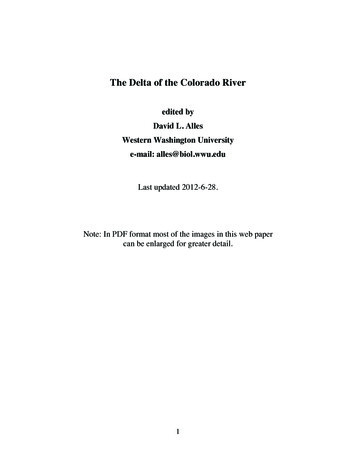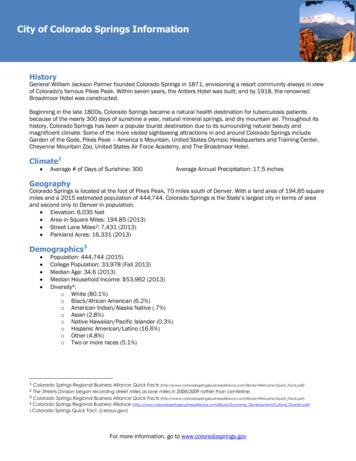
Transcription
The Delta of the Colorado Riveredited byDavid L. AllesWestern Washington Universitye-mail: alles@biol.wwu.eduLast updated 2012-6-28.Note: In PDF format most of the images in this web papercan be enlarged for greater detail.1
IntroductionThe delta region begins just beyond the Colorado River's departure from the UnitedStates' southern boundary, and includes portions of the Mexican states of Sonora and BajaCalifornia stretching south to the upper Gulf of California. The delta once received all of the 15 million acre-feet of annual water flow from the United States. Now only ten percent ofthat flows across the border, all of which is consumed by municipal, industrial, oragricultural users in Mexico. The only water that now regularly reaches the delta regioncomes from agricultural wastewater.The delta ecosystem once occupied more than 2 million acres (3325 square miles)(Sykes, 1937), but has been reduced by more than ninety percent over the past 80 years.Much of the delta habitat that now exists lies just along the river's main channel, or in areasfed by agricultural wastewater drainage. Before the dams were built on the Colorado Riverthe 3325 square mile (8612 square kilometers) delta region was a morass of twisting riverchannels, marshes, and jungle-like riverside forest vegetation.The delta's marshes were once a primary stopover habitat for millions of birdsmigrating on the Pacific Flyway. Today the decline in wetland habitat has forced manymigratory birds to use alternative water sources, including agricultural waste ponds and theSalton Sea, that favor the spread of avian disease and result in increased bird mortality.Several endangered species including the jaguar, desert pupfish, Yuma clapper rail, havealso been adversely affected by the decline of the delta ecosystem.Before the dams so much fresh water flowed down the river that the tidal estuaryextended an estimated 25 miles (40 km) into the northern Gulf of California. The marineenvironment of the Gulf of California achieved its uniqueness in part as a result of thefreshwater inflows from the Colorado River delta. With those flows gone, the estuarineenvironment is becoming increasingly saline, threatening many of the species that inhabitthe gulf region including the endangered totoaba, a large relative of the white sea bass, andthe vaquita harbor porpoise, one of the rarest mammals in the world.Web ov/IOTD/view.php?id 46102
The Colorado River from Yuma, Arizona (lower right)to the Gulf of California(June 28, 2001, International Space Station (ISS) image courtesy of NASA)3
The Colorado River DeltaThe Colorado River empties into the Gulf of California at the northernmost point ofthe gulf. The area is extremely hot and arid with average monthly temperatures in thesummer exceeding 90 F (32 C), and average annual rainfall amounts of 2.4 inches (60 mm)making it the driest region in North America. The large island in the middle of the river’smouth (above just left of center) is Isla Montague. Its long axis is about 20 miles (32 km) inlength. Isla Montague is approximately 65 miles (105 km) due south of Yuma, Arizona.(December 12, 2002, ISS image courtesy of NASA)4
The Colorado River Delta Region
Not more than 80 years ago the Colorado River flowed unhindered from northernColorado through Utah, the Grand Canyon, Arizona, and Mexico before pouring out into theGulf of California. But, as seen in this image of the Colorado River delta taken September8, 2000, by the ASTER instrument aboard NASA’s Terra satellite, irrigation and urbansprawl now prevent the river from reaching the gulf which can be seen in solid blue at thelower right hand corner of the image.6
The Colorado River comes to an end just south of the multicolored patchwork offarmlands in the top left corner of the image and then fans out at the base of the Sierra deMayor mountains (left edge center). A hundred years ago the river would have cut throughthis entire picture and plowed straight through to the Gulf of California. Today nearly all thewater that flows into the Colorado is siphoned off to irrigate crops or for residential use.7
The bluish purple river that appears to be flowing from the Gulf of California to thenorth is actually an inlet that formed in the bed of the Colorado River after it receded. Thegray areas surrounding this inlet and the gulf itself are mud flats created by sediments oncecarried by the river. Dams now trap most of the river's sediments long before they find theirway to the gulf.The flat yellow expanse in the upper right corner is the Gran Desierto del Altar.Between the farmland and the desert is a dark blue pool covered with patches of green.Known as the Ciènega de Santa Clara (ciènaga means wetland in Spanish), it is a saltwatermarsh formed by irrigation wastewater. The white patches to the southeast of this swampyarea are barren salt flats that separate the marsh from the Gulf of California.8
Change began to occur for the delta during the latter part of the 19th century. Shipstraveling north from the Gulf of California would transfer their cargo to river steamboats,such as shown above, that supplied U.S. Army outposts and mining camps along the lowerColorado River. The steamboats were fueled by cottonwood from riverside forests. By theturn of the century hunters and sport fishermen from north of the border were partaking ofthe delta’s bounty. Fishing villages developed on the upper gulf to supply Los Angeles andSan Diego with shrimp, shark, turtle, and totoaba.9
Above is an early example of sport fishing for totoaba in the upper Gulf ofCalifornia. These fish grew to well over 200 pounds in weight, and there are records ofsome that approached 300 pounds. The totoaba migrate from the upper Gulf of California tospawn in the brackish waters of the estuaries of the Colorado River delta.Photograph courtesy of Tony Reyeshttp://www.sanfelipe.com.mx/business/tony reyes/index.html10
The giant totoaba once swarmed the northern Sea of Cortez in schools so thick theycould literally be harpooned with one's eyes held shut. Beginning about 1920, the totoabawere caught by Mexican fishermen using only handlines, and the stocks were notappreciably depleted. In the early years, most of the fish were taken solely for their airbladders, which were dried and sold for use in a Chinese soup that was known as seen kow.The carcasses of the enormous totoaba were left on the beaches to rot.Then, traders began buying the fish for as little as five cents each, and transportingthem to the U.S. By 1942, over four million pounds of totoaba were exported to theSouthern California wholesale market, and still the fish resisted the pressure successfully.But in the 1950s, dynamite and gill nets were used to intercept the totoaba before they couldspawn in the estuaries of the Colorado River, and they became almost extinct within a fewyears.(Photograph courtesy of Tony Reyes)Web 14.htm11
The Mouth of the Colorado River June 28, 2001The dark area above left is the saltwater marsh the Ciènega de Santa Clara. It is hometo perhaps the largest remaining populations of the Yuma clapper rails and desert pupfish,and is a major stopover for migratory waterfowl on the Pacific Flyway.(ISS image courtesy of NASA)12
The Ciènega de Santa Clara (shown above) covers approximately 15,000 acres of saltmarsh and cattails. This image was taken May 17, 2002.(ISS image courtesy of NASA)13
The Ciènega de Santa Clara consists of extensive beds of southern cattails,interspersed with open water. The southern cattail is stress deciduous and goes throughan annual cycle in the marsh of growth and regeneration followed by drying and browning.This undated photograph of the marsh is from the January 2005 issue of the Sonoran JointVenture E-Bulletin. The view is south toward the mouth of the delta. Note the white saltflats running from the edge of the green marsh to the gulf in the upper portion of this image.Web Referencehttp://www.sonoranjv.org/index.html14
The image above shows the cattail beds during their cycle of drying and browning.This undated file photograph of the marsh by Peggy Peattie is from the June 26, 2006, issueof the San Diego Union-Tribune online.In April of 2006, based on NASA satellite imagery, the Ciènega de Santa Clarasuffered a major fire burning a large portion of the cattail beds of the marsh.Web /20060626-9999-1n26delta.html15
April 23, 2006, 1850 UTCMODIS/Terra imageApril 23, 2006, 2025 UTCMODIS/Aqua imageBased on these two images, the fire was either not visible, or started after 1850 UTC,April the 23rd. At 2025 UTC, note the appearance of the gray patch at the north end of themarsh, which may be smoke.16
April 24, 2006, 1755 UTCMODIS/Terra imageApril 24, 2006, 2105 UTCMODIS/Aqua imageBy 1755 UTC on the 24th smoke obscures most of the marsh. By 2105 UTC theMODIS instrument detected two fires in the marsh (red boxes) and a large plume of smokedrifting eastward.17
April 25, 2006MODIS/Terra imageJuly 6, 2006MODIS/Aqua imageThe image above, from April 25th, captured approximately 48 hours after the firstindication of fire, shows much of the marsh may have been blackened by the fire. Thesecond image shows the marsh almost ten weeks later. The Ciènega de Santa Clara appearsreduced in size, but may be showing signs of green regeneration.The April 23 to July 6, 2006, MODIS images are courtesy of NASA's MODIS RapidResponse System, AERONET La Jolla Subset. All of these images are 250 meters per pixelresolution.Web s/?AERONET La Jolla/18
The 59 mile long Main Outlet Drain Extension (MODE)The Wellton-Mohawk Irrigation District (WMID) in southwestern Arizona wasestablished in the 1950s. WMID diverts approximately 400,000 acre-feet of Colorado Riverwater annually to irrigate crops. Already salty Colorado River water, combined with thesaline soil of WMID farmlands, creates a saline groundwater supply. As the underlyinggroundwater basin fills with water from the irrigated fields, salts are pushed to the surface.To keep the salts below the root zone, pumps remove about 130,000 acre-feet of brackishgroundwater annually.In the 1960s, Arizona began pumping this highly saline discharge back into theColorado River at a point below the last dam in the U.S. but before the river reached theMexican border. The United States was then able to deliver to Mexico the quantity of waterestablished by treaty, while ignoring the fact that it was delivering highly saline wastewaterinstead of freshwater. Tensions over the salinity of the water allotted to Mexico escalated tocrisis proportions in the 1970s, when Mexico lodged a formal complaint with the UnitedStates regarding the crop-killing salt water it was receiving. The ultimate solution wasconstruction of a multimillion dollar desalination plant at Yuma, which, once it was up andrunning, would remove the salt from the Wellton-Mohawk wastewater before delivery toMexico.19
The Ciènega de Santa Clara (undated photograph)In the interim, the offending irrigation drainage was rerouted away from the lowerColorado River by a 59 mile (95 km) long concrete canal running to the Ciènega de SantaClara. Since its completion in 1965, the MODE canal has carried 130,000 acre-feet ofwastewater annually to the marsh.Forty years later in 2005, the plant, completed in 1992 after almost 20 years ofconstruction, was still off-line, but the continuous rerouting of Wellton-Mohawk irrigationwastewater had the accidental (but beneficial) side-effect of reviving the Ciènega de SantaClara—one of the most important desert wetlands in the U.S. Southwest or NorthernMexico—from its low point of 500 acres to more than 15,000 acres currently.Web t&ocean/winter2002/pages/six.htm20
Excerpts from Climate Studies Hold Key to Future of Desalination PlantPaleontologists and hydrologists are being called in to help the US governmentdecide what to do with a disused, 400-million desalination plant on the banks of theColorado River. The researchers will study tree rings and clam shells, among other things,in a bid to establish long-term historical climate patterns in the river basin. These will helpthe US Bureau of Reclamation to determine whether it is worth reopening the YumaDesalting Plant, which was designed to remove salt from the river before it reaches Mexico.The plant was completed in Arizona in 1989, after salty water from the ColoradoRiver had upset agricultural and natural ecosystems in Mexico. The salty water had enteredthe river from irrigation run-off from agricultural fields, particularly in western Arizona [theWellton-Mohawk irrigation wastewater]. Other steps taken to address the problem includedbuilding a canal [the MODE channel] to divert agricultural run-off to a marsh near the Gulfof California [the Ciènega de Santa Clara].The desalination plant was operated for a test period of about six months in 1992. Butin January 1993, heavy rains diluted the river, making desalination operations unnecessary.The plant was subsequently criticized in media reports as a waste of taxpayers’ money, andenvironmental groups complained about the potential impact of brine extracted by the plantthat was sent to the Mexican marshland.But a four-year drought in Arizona has led officials to try to find new ways ofsecuring more usable water, while meeting the requirements of the complex laws andtreaties covering the river. A treaty signed in 1944 requires the United States to send 1.85billion cubic metres of water to Mexico via the river, with the salinity level not exceedingset limits. The desalination plant could make a partial contribution to this target byremoving salt from part of the river’s water flow—it can desalinate 92.5 million cubicmetres of water per year.Reopening the plant would cost about 25 million, and annual operating costs arealso about 25 million, so bureau officials only want to do this if it will be needed for asustained period. In January, they convened a group of researchers at the University ofArizona in Tucson to develop a model for predicting droughts and higher-precipitationperiods for the next 50 years.If the scientific studies show that it would be cost-effective to reopen the desalinationplant, bureau officials expect such a move to face legal challenges from environmentalgroups. Just keeping the facility on stand-by costs about 3 million a year. (Dalton, 2003)21
Explanation: The pressure to wring every drop possible from the Colorado River isincreasing. Putting the Yuma desalination plant in operation would mean adding 75,000acre-feet (92.5 million cubic metres) of freshwater per year that would be available for usein Arizona. This would cost 25 million per year and represent a direct subsidy from thefederal government. That same water is currently going to the Ciènega de Santa Clara. Thepresent situation gives Mexico 1.5 million acre-feet (1.85 billion cubic metres) per year offreshwater from the Imperial Dam and 130,000 acre-feet of Wellton-Mohawk irrigationwastewater from Arizona that now maintains the vitality of the Ciènega de Santa Clara. Ifthe desalination plant starts up, the annual 130,000 acre-feet of brackish Wellton-Mohawkirrigation wastewater flowing to the marsh would be replaced by 55,000 acre-feet ofextremely saline brine. This could mean the destruction of the Ciènega de Santa Clara marshhabitat.And the news from the scientists is not good."Preliminary results suggest that the historical record of flow is not typical of long-termvariation and that the southwest is in general drier than the past century has been." "Whatthis is telling us is that on average, the historical record, the last 100 years in the SouthwestUnited States has been on the really wet side. This is a conclusion that otherpaleoclimatologists, tree ring scientists and so on have already suggested on the basis ofmuch shorter records. And what we're doing is we pushed this back to the 2,000 year marknow and we're tending to agree with them. So, basically our historical record, which is arecord upon which we base all of our plans for development of the Southwest, ourinternational agreements about how much water we keep in the United States and how muchwater goes to Mexico, is based on a biased sample of the distribution of flows from theColorado River or a biased sample of the distribution of precipitation in the Southwest."Dr. Peter D. Roopnarine, Asst. Curator, Department of Invertebrate Zoology & Geology,California Academy of Science, from The Silence of the Clams available ine/toc.htmlWhat this means, if the scientists are correct, is that over the long term the operationof the Yuma desalination plant will be needed just to maintain current levels of freshwateruse and thus may spell the end of the Ciènega de Santa Clara.22
Bureau of Reclamation Desalting Plant in Yuma, AZIn 2007, federal officials restarted the idled Yuma desalination plant. The Ciènega deSanta Clara marsh had been under continuous threat as U.S. water managers kept an eye onthe flow to the ciènaga. The desalination facility in Yuma was opened in 1992, by the U.S.Bureau of Reclamation to treat saline wastewater, but costs were prohibitive and the planthas been closed since 1993. Drought has changed all that. Arizona water managers, who arefirst in line to have their water cut in a shortage under an agreement with other states, calledfor the plant to be turned on.Under an agreement with environmentalists, the federal Bureau of Reclamation plansto monitor the environmental effects of using the plant, and study, among other things, usingthe purified water for purposes other than meeting its treaty obligations, such as supplyingthe growing communities around Yuma. (Archibold & Johnson, 2007, April 4)23
Aldo Leopold (1887-1948)The Green LagoonsBefore the dams were built, the Colorado River delta extended over two millionacres, an area almost the size of Rhode Island, rich with nutrients brought downriver withtons of silt. In 1922, the conservationist Aldo Leopold and his brother explored the ColoradoRiver delta by canoe. Leopold exulted in “all the wealth of fowl and fish in this milk-andhoney wilderness” as his canoe wove through winding waterways and green lagoons. Thetwo subsisted on quail and geese they harvested. Beaver, deer, and jaguar flourished, whileshrimp and the totoaba, migrated from the upper Gulf of California to spawn in the delta’sbrackish waters. Millions of waterfowl and shorebirds could be seen circling, thendescending to feed and rest in the lagoons. Leopold’s essay The Green Lagoons in his bookA Sand County Almanac (1949), gives a description of the delta as it was then. Thefollowing excerpts from the essay give a feeling for what has been lost.Web 5604/aldoleopoldcoloradodelta1.htm24
(Painting of an Egret by Ray Harris-Ching)“Dawn on the delta was whistled in by Gambel quail, which roosted in themesquites overhanging camp. When the sun peeped over the Sierra Madre, itslanted across a hundred miles of lovely desolation, a vast flat bowl of wildernessrimmed by jagged peaks. On the map the delta was bisected by the river, but infact the river was nowhere and everywhere, for he could not decide which of ahundred green lagoons offered the most pleasant and least speedy path to thegulf. So he traveled them all, and so did we. He divided and rejoined, he twistedand turned, he meandered in awesome jungles, he all but ran in circles, he dalliedwith lovely groves, he got lost and was glad of it, and so were we.”“The still waters were of a deep emerald hue, colored by algae, I suppose,but no less green for all that. At each bend we saw egrets standing in the poolsahead, each white statue matched by its white reflection.”25
ReferencesArchibold, R. C. & Johnson, K. (2007, April 4). An Arid West No Longer Waits for Rain.The New York Times, U.S.Dalton, R. (2003). Climate Studies Hold Key to Future of Desalination Plant. Nature, 422(March 6), 4-5.Sykes, G., 1937. The Colorado River Delta. American Geographical Society SpecialPublication, no. 19, American Geographical Society, New York, New YorkFor further information on the delta of the Colorado River see:Missing Water by the Pacific Institutehttp://www.pacinst.org/reports/missing water/Since the dams: Historical Ecology of the Colorado d.htmDead Delta’s Former df-----------------------To return to the Colorado River Index go ver.htmlFor the next paper in this series on the Colorado River go to:http://fire.biol.wwu.edu/trent/alles/Sea of Cortez.pdfFor further information on related topics go to:Global Ecology and Remote Ecologyindex.htmlAlles Biology Home l26
the 3325 square mile (8612 square kilometers) delta region was a morass of twisting river channels, marshes, and jungle-like riverside forest vegetation. . The bluish purple river that appears to be flowing from the Gulf of California to the north is actually an inlet that formed in the bed of the Colorado River after it receded. The










